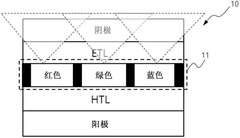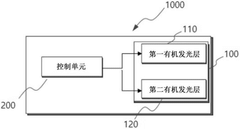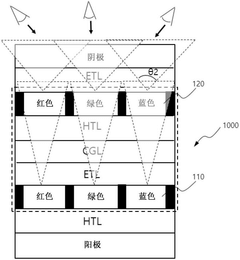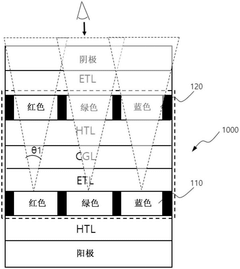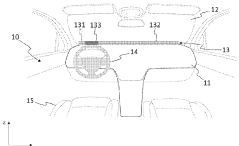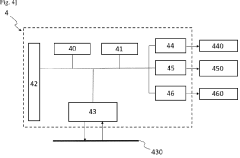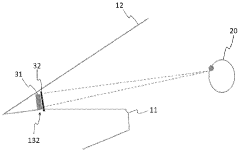ULED Displays in Automotive Infotainment: A Guide
JUN 23, 20259 MIN READ
Generate Your Research Report Instantly with AI Agent
Patsnap Eureka helps you evaluate technical feasibility & market potential.
ULED Display Evolution
The evolution of ULED (Ultra Light Emitting Diode) displays in automotive infotainment systems represents a significant leap forward in display technology. This progression has been driven by the increasing demand for high-quality, energy-efficient, and versatile display solutions in modern vehicles.
Initially, automotive displays were limited to basic LCD screens with low resolution and poor visibility in varying light conditions. The introduction of LED-backlit displays marked the first major improvement, offering better brightness and contrast. However, these early LED displays still faced challenges in terms of power consumption and heat generation.
The development of ULED technology addressed many of these limitations. ULED displays utilize ultra-small LED chips, typically measuring less than 100 micrometers, allowing for higher pixel density and improved image quality. This miniaturization also enables more precise control over local dimming, resulting in superior contrast ratios and deeper blacks compared to traditional LED displays.
A key milestone in ULED evolution was the implementation of Quantum Dot technology. By incorporating quantum dots into the display structure, manufacturers achieved a wider color gamut and enhanced color accuracy. This advancement was particularly crucial for automotive applications, where vibrant and accurate color reproduction is essential for both aesthetic appeal and safety-related information display.
The integration of ULED technology with flexible substrates marked another significant development. This innovation allowed for the creation of curved and irregularly shaped displays, perfectly aligning with the complex interior designs of modern vehicles. Flexible ULED displays not only enhanced the aesthetic appeal of automotive interiors but also improved space utilization and ergonomics.
Recent advancements in ULED technology have focused on improving energy efficiency and reducing heat generation. The development of more efficient LED drivers and advanced thermal management systems has allowed for brighter displays with lower power consumption, addressing one of the primary concerns in automotive applications.
The latest generation of ULED displays incorporates micro-LED technology, pushing the boundaries of pixel density and image quality even further. These displays offer unprecedented levels of brightness, contrast, and color accuracy, while maintaining excellent power efficiency. The modular nature of micro-LED technology also provides enhanced durability and longer lifespan, crucial factors in the automotive environment.
Looking ahead, the evolution of ULED displays in automotive infotainment is likely to continue focusing on further miniaturization, improved energy efficiency, and enhanced integration with other vehicle systems. The development of transparent ULED displays and their potential application in heads-up displays and smart windows represents an exciting frontier in this field.
Initially, automotive displays were limited to basic LCD screens with low resolution and poor visibility in varying light conditions. The introduction of LED-backlit displays marked the first major improvement, offering better brightness and contrast. However, these early LED displays still faced challenges in terms of power consumption and heat generation.
The development of ULED technology addressed many of these limitations. ULED displays utilize ultra-small LED chips, typically measuring less than 100 micrometers, allowing for higher pixel density and improved image quality. This miniaturization also enables more precise control over local dimming, resulting in superior contrast ratios and deeper blacks compared to traditional LED displays.
A key milestone in ULED evolution was the implementation of Quantum Dot technology. By incorporating quantum dots into the display structure, manufacturers achieved a wider color gamut and enhanced color accuracy. This advancement was particularly crucial for automotive applications, where vibrant and accurate color reproduction is essential for both aesthetic appeal and safety-related information display.
The integration of ULED technology with flexible substrates marked another significant development. This innovation allowed for the creation of curved and irregularly shaped displays, perfectly aligning with the complex interior designs of modern vehicles. Flexible ULED displays not only enhanced the aesthetic appeal of automotive interiors but also improved space utilization and ergonomics.
Recent advancements in ULED technology have focused on improving energy efficiency and reducing heat generation. The development of more efficient LED drivers and advanced thermal management systems has allowed for brighter displays with lower power consumption, addressing one of the primary concerns in automotive applications.
The latest generation of ULED displays incorporates micro-LED technology, pushing the boundaries of pixel density and image quality even further. These displays offer unprecedented levels of brightness, contrast, and color accuracy, while maintaining excellent power efficiency. The modular nature of micro-LED technology also provides enhanced durability and longer lifespan, crucial factors in the automotive environment.
Looking ahead, the evolution of ULED displays in automotive infotainment is likely to continue focusing on further miniaturization, improved energy efficiency, and enhanced integration with other vehicle systems. The development of transparent ULED displays and their potential application in heads-up displays and smart windows represents an exciting frontier in this field.
Automotive HMI Trends
The automotive industry is witnessing a significant shift in Human-Machine Interface (HMI) trends, driven by advancements in display technologies and changing consumer expectations. The integration of ULED (Ultra Light Emitting Diode) displays in automotive infotainment systems represents a cutting-edge development in this domain, offering enhanced visual experiences and improved functionality.
One of the primary trends in automotive HMI is the move towards larger, more immersive displays. Manufacturers are increasingly adopting expansive screens that span across the dashboard, providing a seamless and integrated user interface. These displays often incorporate curved or flexible ULED panels, allowing for more ergonomic designs that blend seamlessly with the vehicle's interior aesthetics.
Another notable trend is the emphasis on high-resolution and high-contrast displays. ULED technology excels in this area, offering superior brightness, deeper blacks, and more vibrant colors compared to traditional LCD screens. This improvement in visual quality enhances the legibility of information, especially in challenging lighting conditions such as direct sunlight.
Customization and personalization have become key focus areas in automotive HMI design. ULED displays enable more sophisticated user interfaces that can be tailored to individual preferences. This includes customizable layouts, themes, and the ability to prioritize certain information based on driver preferences or driving conditions.
The integration of advanced driver assistance systems (ADAS) with infotainment displays is another significant trend. ULED screens are being utilized to present critical safety information, such as lane departure warnings, collision alerts, and navigation guidance, in a more visually striking and attention-grabbing manner.
Touch-free interaction is gaining prominence in automotive HMI, with gesture control and voice recognition becoming more sophisticated. ULED displays complement these technologies by providing responsive visual feedback and clear, high-contrast interfaces that are easily readable from various angles within the vehicle.
Energy efficiency is a crucial consideration in automotive design, and ULED technology addresses this concern. These displays consume less power compared to traditional LCD screens, contributing to improved fuel efficiency in conventional vehicles and extended range in electric vehicles.
The trend towards connected and autonomous vehicles is also shaping HMI design. ULED displays are being leveraged to create more intuitive interfaces for complex infotainment systems, integrating features like real-time traffic updates, vehicle diagnostics, and connectivity with smart home devices.
As vehicles become more software-defined, the ability to update and upgrade infotainment systems over-the-air is becoming increasingly important. ULED displays, with their superior visual capabilities, ensure that new features and interface improvements can be fully appreciated by users, future-proofing the vehicle's HMI.
One of the primary trends in automotive HMI is the move towards larger, more immersive displays. Manufacturers are increasingly adopting expansive screens that span across the dashboard, providing a seamless and integrated user interface. These displays often incorporate curved or flexible ULED panels, allowing for more ergonomic designs that blend seamlessly with the vehicle's interior aesthetics.
Another notable trend is the emphasis on high-resolution and high-contrast displays. ULED technology excels in this area, offering superior brightness, deeper blacks, and more vibrant colors compared to traditional LCD screens. This improvement in visual quality enhances the legibility of information, especially in challenging lighting conditions such as direct sunlight.
Customization and personalization have become key focus areas in automotive HMI design. ULED displays enable more sophisticated user interfaces that can be tailored to individual preferences. This includes customizable layouts, themes, and the ability to prioritize certain information based on driver preferences or driving conditions.
The integration of advanced driver assistance systems (ADAS) with infotainment displays is another significant trend. ULED screens are being utilized to present critical safety information, such as lane departure warnings, collision alerts, and navigation guidance, in a more visually striking and attention-grabbing manner.
Touch-free interaction is gaining prominence in automotive HMI, with gesture control and voice recognition becoming more sophisticated. ULED displays complement these technologies by providing responsive visual feedback and clear, high-contrast interfaces that are easily readable from various angles within the vehicle.
Energy efficiency is a crucial consideration in automotive design, and ULED technology addresses this concern. These displays consume less power compared to traditional LCD screens, contributing to improved fuel efficiency in conventional vehicles and extended range in electric vehicles.
The trend towards connected and autonomous vehicles is also shaping HMI design. ULED displays are being leveraged to create more intuitive interfaces for complex infotainment systems, integrating features like real-time traffic updates, vehicle diagnostics, and connectivity with smart home devices.
As vehicles become more software-defined, the ability to update and upgrade infotainment systems over-the-air is becoming increasingly important. ULED displays, with their superior visual capabilities, ensure that new features and interface improvements can be fully appreciated by users, future-proofing the vehicle's HMI.
ULED Tech Challenges
ULED (Ultra Light Emitting Diode) displays face several significant technical challenges in their application to automotive infotainment systems. One of the primary hurdles is achieving sufficient brightness and contrast ratios to ensure visibility in varying light conditions, particularly in direct sunlight. This is crucial for automotive applications where readability is essential for safety and user experience.
Another major challenge lies in the thermal management of ULED displays. The automotive environment presents extreme temperature fluctuations, from sub-zero temperatures to intense heat. Ensuring consistent performance and longevity of ULED displays under these conditions requires advanced thermal design and materials engineering.
Color accuracy and uniformity pose additional challenges. Automotive infotainment systems demand precise color reproduction for brand consistency and user interface design. Achieving uniform color and brightness across the entire display surface, especially in larger formats, remains a technical hurdle for ULED technology.
The integration of touch functionality with ULED displays presents its own set of challenges. Balancing the need for responsive touch interfaces with the optical requirements of ULED technology requires innovative approaches to sensor design and integration.
Durability and reliability are paramount in automotive applications. ULED displays must withstand vibrations, shocks, and long-term exposure to UV radiation. Developing robust encapsulation methods and protective coatings that do not compromise display quality is an ongoing challenge.
Power efficiency is another critical area of focus. While ULEDs are generally more energy-efficient than traditional LEDs, further improvements are necessary to meet the stringent power requirements of modern vehicles, especially with the trend towards electric and hybrid powertrains.
Manufacturing scalability and cost-effectiveness present significant hurdles. The automotive industry demands high-volume production with consistent quality. Developing manufacturing processes that can produce ULED displays at scale while maintaining tight tolerances and yield rates is a major technical challenge.
Lastly, the integration of ULED displays with other vehicle systems poses interoperability challenges. Ensuring seamless communication and synchronization with other onboard electronics, such as navigation systems, climate controls, and driver assistance features, requires sophisticated software and hardware integration strategies.
Addressing these technical challenges is crucial for the widespread adoption of ULED displays in automotive infotainment systems. Ongoing research and development efforts are focused on overcoming these hurdles to fully realize the potential of ULED technology in enhancing the driving experience and vehicle functionality.
Another major challenge lies in the thermal management of ULED displays. The automotive environment presents extreme temperature fluctuations, from sub-zero temperatures to intense heat. Ensuring consistent performance and longevity of ULED displays under these conditions requires advanced thermal design and materials engineering.
Color accuracy and uniformity pose additional challenges. Automotive infotainment systems demand precise color reproduction for brand consistency and user interface design. Achieving uniform color and brightness across the entire display surface, especially in larger formats, remains a technical hurdle for ULED technology.
The integration of touch functionality with ULED displays presents its own set of challenges. Balancing the need for responsive touch interfaces with the optical requirements of ULED technology requires innovative approaches to sensor design and integration.
Durability and reliability are paramount in automotive applications. ULED displays must withstand vibrations, shocks, and long-term exposure to UV radiation. Developing robust encapsulation methods and protective coatings that do not compromise display quality is an ongoing challenge.
Power efficiency is another critical area of focus. While ULEDs are generally more energy-efficient than traditional LEDs, further improvements are necessary to meet the stringent power requirements of modern vehicles, especially with the trend towards electric and hybrid powertrains.
Manufacturing scalability and cost-effectiveness present significant hurdles. The automotive industry demands high-volume production with consistent quality. Developing manufacturing processes that can produce ULED displays at scale while maintaining tight tolerances and yield rates is a major technical challenge.
Lastly, the integration of ULED displays with other vehicle systems poses interoperability challenges. Ensuring seamless communication and synchronization with other onboard electronics, such as navigation systems, climate controls, and driver assistance features, requires sophisticated software and hardware integration strategies.
Addressing these technical challenges is crucial for the widespread adoption of ULED displays in automotive infotainment systems. Ongoing research and development efforts are focused on overcoming these hurdles to fully realize the potential of ULED technology in enhancing the driving experience and vehicle functionality.
ULED Integration
01 ULED display structure and manufacturing
ULED displays incorporate advanced structural designs and manufacturing processes to enhance performance. This includes innovations in pixel arrangements, substrate materials, and fabrication techniques to improve efficiency, brightness, and color accuracy. The technology focuses on miniaturizing LED components while maintaining high image quality and energy efficiency.- ULED display structure and manufacturing: ULED displays incorporate advanced structural designs and manufacturing techniques to enhance performance. This includes innovations in pixel arrangements, substrate materials, and fabrication processes to improve efficiency, brightness, and color accuracy. The technology focuses on miniaturizing LED components while maintaining high luminosity and energy efficiency.
- Driving and control mechanisms for ULED displays: Specialized driving circuits and control mechanisms are developed for ULED displays to optimize performance. These systems manage power distribution, pixel addressing, and brightness control. Advanced algorithms and hardware solutions are implemented to ensure uniform illumination, reduce power consumption, and enhance overall display quality.
- Integration of ULED technology in various devices: ULED technology is being integrated into a wide range of devices, including smartphones, televisions, and automotive displays. This integration requires adapting the technology to different form factors and use cases, addressing challenges such as heat dissipation, power efficiency, and durability in various environments.
- Color management and image quality enhancement: ULED displays employ advanced color management techniques and image quality enhancement algorithms. These include methods for improving color gamut, contrast ratio, and HDR performance. Specialized optical designs and color conversion technologies are utilized to achieve superior visual experiences and accurate color reproduction.
- Energy efficiency and sustainability in ULED technology: Efforts are focused on improving the energy efficiency and sustainability of ULED displays. This includes developing low-power driving schemes, implementing intelligent brightness control, and using eco-friendly materials in manufacturing. Research is also conducted on extending the lifespan of ULED components and reducing electronic waste.
02 Driving and control systems for ULED displays
Specialized driving and control systems are developed for ULED displays to manage power distribution, pixel addressing, and image processing. These systems optimize display performance, reduce power consumption, and enable features such as high refresh rates and dynamic range control. Advanced algorithms and circuitry are employed to ensure precise control over each LED element.Expand Specific Solutions03 Optical enhancements for ULED displays
Various optical technologies are integrated into ULED displays to improve visual quality. This includes the use of micro-lenses, light-guiding structures, and specialized coatings to enhance light extraction, reduce reflection, and improve viewing angles. These optical enhancements contribute to better contrast, color reproduction, and overall image quality.Expand Specific Solutions04 Thermal management in ULED displays
Effective thermal management is crucial for ULED displays to maintain performance and longevity. Innovative heat dissipation methods, including advanced materials and structural designs, are employed to efficiently remove heat generated by the LEDs. This ensures stable operation, prevents color shift, and extends the lifespan of the display.Expand Specific Solutions05 Integration of ULED displays in devices
ULED display technology is being integrated into various devices and applications. This includes innovations in flexible and foldable displays, as well as adaptations for specific use cases such as automotive displays, wearables, and large-format screens. The integration focuses on optimizing form factors, power efficiency, and durability for different device types.Expand Specific Solutions
Key ULED Manufacturers
The ULED display market in automotive infotainment is in a growth phase, with increasing adoption and technological advancements. The market size is expanding rapidly due to rising demand for enhanced in-vehicle experiences. Technologically, ULED displays are maturing, with major players like GM Global Technology Operations, Volkswagen AG, and Ford Global Technologies leading innovation. Companies such as Continental Automotive Technologies, Visteon Global Technologies, and Hyundai Mobis are also making significant contributions. The competitive landscape is diverse, including traditional automakers, tier-1 suppliers, and specialized electronics manufacturers. As the technology evolves, we're seeing a trend towards higher resolution, improved energy efficiency, and integration with other vehicle systems, indicating a promising future for ULED displays in automotive applications.
Volkswagen AG
Technical Solution: Volkswagen AG has developed an advanced ULED (Ultra Light Emitting Diode) display system for automotive infotainment. Their technology integrates high-resolution ULED panels with a proprietary image processing algorithm to enhance brightness, contrast, and color accuracy. The system features a modular design that allows for seamless integration into various vehicle models, with screen sizes ranging from 10 to 15 inches. Volkswagen's ULED displays incorporate touch functionality and support gesture control, providing an intuitive user interface. The displays are also designed to minimize power consumption and heat generation, crucial for automotive applications.
Strengths: Superior image quality, modular design for easy integration, advanced user interface. Weaknesses: Potentially higher cost compared to traditional displays, may require specialized maintenance.
Ford Global Technologies LLC
Technical Solution: Ford Global Technologies has developed a cutting-edge ULED display system for automotive infotainment. Their solution incorporates a high-density ULED panel with Ford's SYNC 4 infotainment system, offering seamless connectivity and integration with vehicle functions. The display features adaptive brightness control, automatically adjusting to ambient light conditions for optimal visibility. Ford's system also includes a unique split-screen functionality, allowing users to simultaneously view navigation and media information. The ULED technology provides enhanced durability and longevity compared to traditional LCD displays, with improved resistance to temperature fluctuations and vibrations common in automotive environments.
Strengths: Seamless integration with Ford's SYNC system, adaptive brightness, enhanced durability. Weaknesses: Potentially limited to Ford vehicles, may require frequent software updates.
ULED Patents Analysis
OLED display system and control method thereof
PatentPendingCN119380659A
Innovation
- Organic luminous elements (OLED) display systems are adopted, and the control unit controls the turnover/control of the first and second organic hair light layers based on the speed of the mobile object to achieve perspective control, ensuring that the image can only be seen in the driver's direction.
vehicle display system and vehicle comprising such a display system
PatentInactiveFR3125117A1
Innovation
- A display system comprising a head-up display device with a blade and two LED matrix display devices arranged to form a panel between the windshield and dashboard, providing a large, easily accessible display surface that combines high resolution and low cost.
Automotive Standards
Automotive standards play a crucial role in ensuring the safety, reliability, and performance of ULED displays in automotive infotainment systems. These standards are developed and maintained by various international organizations and regulatory bodies to establish uniform requirements across the automotive industry.
One of the primary standards governing automotive displays is the ISO 15008, which specifies the ergonomic aspects of transport information and control systems. This standard focuses on the visual presentation of information to drivers, including requirements for contrast, luminance, and color. For ULED displays in automotive infotainment systems, compliance with ISO 15008 is essential to ensure optimal readability and minimize driver distraction.
The Society of Automotive Engineers (SAE) has also developed several standards relevant to automotive displays. SAE J1757-1 provides guidelines for the optical performance of automotive displays, including specifications for luminance, contrast, and color gamut. This standard is particularly important for ULED displays, as it helps ensure consistent and high-quality visual performance across different lighting conditions.
Electromagnetic compatibility (EMC) is another critical aspect of automotive electronics, including ULED displays. The CISPR 25 standard, developed by the International Special Committee on Radio Interference, sets limits for electromagnetic emissions from vehicles and their components. ULED display manufacturers must adhere to these standards to prevent interference with other electronic systems in the vehicle.
In terms of environmental durability, the AEC-Q100 standard, developed by the Automotive Electronics Council, defines stress test qualification requirements for integrated circuits in automotive applications. While not specific to displays, this standard is relevant for the electronic components used in ULED display systems, ensuring their reliability under various environmental conditions.
Safety considerations are addressed by standards such as ISO 26262, which focuses on functional safety in road vehicles. This standard is particularly important for ULED displays that may be part of critical information systems or advanced driver assistance features.
As automotive technology continues to evolve, new standards are being developed to address emerging technologies. For instance, the MIPI Alliance has introduced the MIPI A-PHY standard, which is designed to support high-speed data transfer for automotive displays and sensors. This standard is particularly relevant for ULED displays, which often require high bandwidth for their advanced features and high-resolution content.
Compliance with these automotive standards is not only a regulatory requirement but also a key factor in ensuring the quality, safety, and market acceptance of ULED displays in automotive infotainment systems. Manufacturers and suppliers must stay informed about updates to these standards and incorporate them into their product development processes to remain competitive in the automotive market.
One of the primary standards governing automotive displays is the ISO 15008, which specifies the ergonomic aspects of transport information and control systems. This standard focuses on the visual presentation of information to drivers, including requirements for contrast, luminance, and color. For ULED displays in automotive infotainment systems, compliance with ISO 15008 is essential to ensure optimal readability and minimize driver distraction.
The Society of Automotive Engineers (SAE) has also developed several standards relevant to automotive displays. SAE J1757-1 provides guidelines for the optical performance of automotive displays, including specifications for luminance, contrast, and color gamut. This standard is particularly important for ULED displays, as it helps ensure consistent and high-quality visual performance across different lighting conditions.
Electromagnetic compatibility (EMC) is another critical aspect of automotive electronics, including ULED displays. The CISPR 25 standard, developed by the International Special Committee on Radio Interference, sets limits for electromagnetic emissions from vehicles and their components. ULED display manufacturers must adhere to these standards to prevent interference with other electronic systems in the vehicle.
In terms of environmental durability, the AEC-Q100 standard, developed by the Automotive Electronics Council, defines stress test qualification requirements for integrated circuits in automotive applications. While not specific to displays, this standard is relevant for the electronic components used in ULED display systems, ensuring their reliability under various environmental conditions.
Safety considerations are addressed by standards such as ISO 26262, which focuses on functional safety in road vehicles. This standard is particularly important for ULED displays that may be part of critical information systems or advanced driver assistance features.
As automotive technology continues to evolve, new standards are being developed to address emerging technologies. For instance, the MIPI Alliance has introduced the MIPI A-PHY standard, which is designed to support high-speed data transfer for automotive displays and sensors. This standard is particularly relevant for ULED displays, which often require high bandwidth for their advanced features and high-resolution content.
Compliance with these automotive standards is not only a regulatory requirement but also a key factor in ensuring the quality, safety, and market acceptance of ULED displays in automotive infotainment systems. Manufacturers and suppliers must stay informed about updates to these standards and incorporate them into their product development processes to remain competitive in the automotive market.
ULED Energy Efficiency
ULED (Ultra Light Emitting Diode) technology has emerged as a promising solution for automotive infotainment displays, offering significant advantages in terms of energy efficiency. The energy-saving characteristics of ULED displays are particularly crucial in the automotive sector, where power consumption directly impacts vehicle performance and range, especially in electric vehicles.
ULED displays achieve their superior energy efficiency through several key technological innovations. Firstly, they utilize advanced light management techniques, including micro-lens arrays and reflective structures, which significantly enhance light extraction and reduce internal light loss. This allows ULEDs to produce the same level of brightness as traditional LED displays while consuming less power.
Furthermore, ULED technology incorporates sophisticated local dimming algorithms. These algorithms enable precise control over individual LED zones, allowing for dynamic adjustment of brightness levels across the display. By selectively dimming or turning off LEDs in darker areas of the image, ULEDs can dramatically reduce overall power consumption without compromising visual quality.
The pixel structure of ULED displays also contributes to their energy efficiency. By employing smaller, more densely packed LED chips, ULEDs can achieve higher pixel densities while maintaining lower power requirements. This not only improves energy efficiency but also enhances display resolution and image quality.
Another factor contributing to ULED's energy efficiency is its improved thermal management. ULEDs generate less heat compared to traditional LED displays, reducing the need for energy-intensive cooling systems. This not only directly saves power but also indirectly improves efficiency by allowing the display to operate at optimal temperatures.
In automotive applications, ULED displays have demonstrated energy savings of up to 50% compared to conventional LED displays. This significant reduction in power consumption translates to extended battery life in electric vehicles and improved fuel efficiency in traditional combustion engine vehicles.
The energy efficiency of ULED technology also aligns well with the growing trend of sustainability in the automotive industry. As manufacturers strive to meet increasingly stringent environmental regulations, the adoption of energy-efficient components like ULED displays becomes increasingly important.
Looking ahead, ongoing research and development in ULED technology promise further improvements in energy efficiency. Areas of focus include enhancing the quantum efficiency of LED materials, developing more sophisticated power management systems, and exploring new pixel architectures that can further reduce power consumption while maintaining or improving display performance.
ULED displays achieve their superior energy efficiency through several key technological innovations. Firstly, they utilize advanced light management techniques, including micro-lens arrays and reflective structures, which significantly enhance light extraction and reduce internal light loss. This allows ULEDs to produce the same level of brightness as traditional LED displays while consuming less power.
Furthermore, ULED technology incorporates sophisticated local dimming algorithms. These algorithms enable precise control over individual LED zones, allowing for dynamic adjustment of brightness levels across the display. By selectively dimming or turning off LEDs in darker areas of the image, ULEDs can dramatically reduce overall power consumption without compromising visual quality.
The pixel structure of ULED displays also contributes to their energy efficiency. By employing smaller, more densely packed LED chips, ULEDs can achieve higher pixel densities while maintaining lower power requirements. This not only improves energy efficiency but also enhances display resolution and image quality.
Another factor contributing to ULED's energy efficiency is its improved thermal management. ULEDs generate less heat compared to traditional LED displays, reducing the need for energy-intensive cooling systems. This not only directly saves power but also indirectly improves efficiency by allowing the display to operate at optimal temperatures.
In automotive applications, ULED displays have demonstrated energy savings of up to 50% compared to conventional LED displays. This significant reduction in power consumption translates to extended battery life in electric vehicles and improved fuel efficiency in traditional combustion engine vehicles.
The energy efficiency of ULED technology also aligns well with the growing trend of sustainability in the automotive industry. As manufacturers strive to meet increasingly stringent environmental regulations, the adoption of energy-efficient components like ULED displays becomes increasingly important.
Looking ahead, ongoing research and development in ULED technology promise further improvements in energy efficiency. Areas of focus include enhancing the quantum efficiency of LED materials, developing more sophisticated power management systems, and exploring new pixel architectures that can further reduce power consumption while maintaining or improving display performance.
Unlock deeper insights with Patsnap Eureka Quick Research — get a full tech report to explore trends and direct your research. Try now!
Generate Your Research Report Instantly with AI Agent
Supercharge your innovation with Patsnap Eureka AI Agent Platform!
